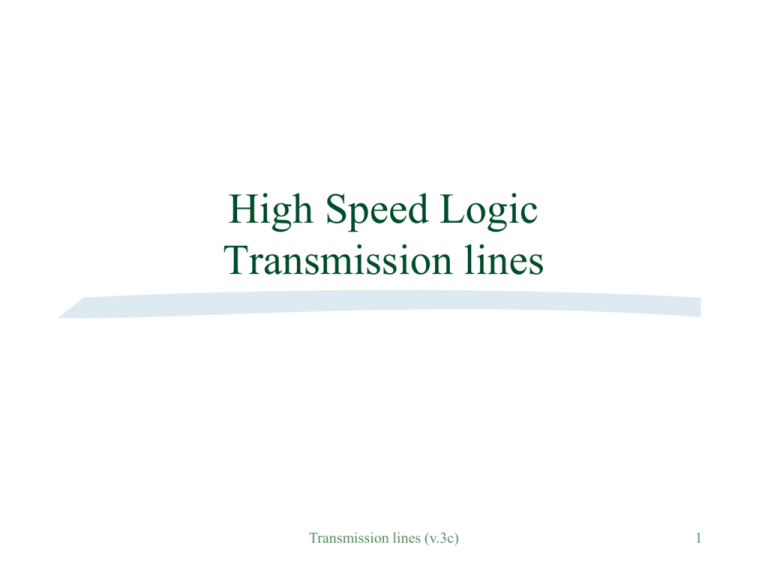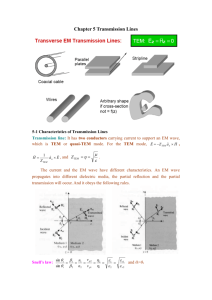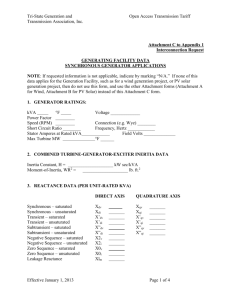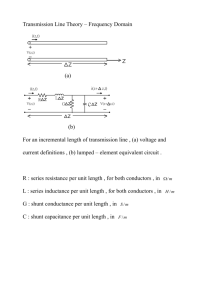Chapter 4 - Transmission lines
advertisement

High Speed Logic
Transmission lines
Transmission lines (v.3c)
1
Transmission lines overview
(1) Characteristics of and applications of
Transmission lines
(3) Reflections in transmission lines and
methods to reduce them
Appendix1
Mathematics of transmission lines
Transmission lines (v.3c)
2
(1) Characteristics of and
applications of Transmission lines
Advantages:
Less distortion, radiation (EMI), cross-talk
Disadvantage
More power required.
Applications, can hanlde
Signals traveling in long distance in Printedcircuit-board PCB
Signals in a cables, connectors (USB, PCI).
Transmission lines (v.3c)
3
Advantage of using transmission lines:
Reduce Electromagnetic Interference
(EMI) in point-to-point wiring
Wire-wrap connections create EMI.
Transmission lines reduce EMI because,
Current loop area is small, also it constraints
the return current (in ground plane) closer to
the outgoing signal path, magnetic current
cancel each other.
Transmission lines (v.3c)
4
Transmission line problem (Ringing)
Ring as wave transmit from source to load
and reflected back and forth.
Source
end
Source
termination
Load
end
Long transmission line
Solution: Source termination method
or load termination
method(see
later)
Transmission
lines (v.3c)
Load
termination
5
The testing board
Demo
http://youtu.be/ezGrGXSV3-s
Source
32MHz
square
wave
Source
When R=∞
(open circuit)
Long transmission line (50 )
Source
Transmission lines (v.3c)
Load
When
R=50
(Matched
load)
Load
R=50
6
Cross sections of transmission lines to show
how constant capacitance and inductance per
unit length are maintained
Transmission lines (v.3c)
7
A transmission line
Connector and 50 terminator
Cross section of
Coaxial transmission
Transmission lines (v.3c)
http://i.ehow.com/images/GlobalPhoto/Articles/5194840/284225-main_Full.jpg
8
Characteristic of a transmission
line
A transmission line has a Characteristic
impedance of Z0
Typically 50 Ohms for a coaxial cable
That means no matter where ( a distance of x
meters from the source) you measure the voltage
Vx over current Ix at a line is Vx/Ix=50 Ohms
Source
Zs
ZL
At x,
Transmission lines (v.3c)
Z0=Vx/Ix=50 Ohms
Load
9
Reflections in transmission lines
Signals inside the line
(assume the signal frequency is a
constant)
Transmission lines (v.3c)
10
Define voltages/ functions of the line
A=Vi/Vs= Input acceptance function
T= Vt/Vi=Output transmission function
R2 =Vr/Vi=load-end reflective coefficient
A=Vi/Vs
Rs
Vs
Z0
R1
Vi
R2 =Vr/Vi
Ir
Ii
It
Vr
Vt
Source end
T=Vt/Vi
ZL=
Load
Load end
Transmission lines (v.3c)
11
Load-end reflection
Load-end reflective coefficient R2
Output transmission function T
Transmission lines (v.3c)
12
Find Load-end reflective coefficient R2=Vr/Vi
R2
Vt=Vi+Vr
Ir
Ii
Vi=Ii Z0
Vr
Ii- Ir =It (kircoff law) Vi Z0
Vi/Z0-Vr/Z0=Vt/ZL
Vi/Z0-Vr/ Z0 =Vi/ ZL +Vr/ZL
Vr/ Z0+Vr/ ZL = Vi/ Z0-Vi/ZL
after rearrangement, hence
R2=Vr/Vi= [ZL- Z0 ]/ [ZL + Z0 ]
Transmission lines (v.3c)
It
T
Vt
Load
ZL
13
Z L Zo Zo
Load - end reflective coefficien t R2
1
Z L Zo Z L
R2 in different types of ZL
Zo
1
ZL
(1) Output doubled
(case 1) Open circuit at load ZL =
R2=[1-Z0/ ]/[1+Z0/ ]=1
(*The output is doubled; used in PCI bus)
(case 2) Shorted circuit at load, ZL =0
R2,= -1 (phase reversal)
(case 3) Matched line ZL = Z0
=characteristic impedance
R2,= 0 (no reflection) (perfect!!)
Transmission lines (v.3c)
ZL =
(2) Signal reflect back
To source
ZL =0
(3) Perfect
Z0
14
Load-end transmission
Output transmission function T
Transmission lines (v.3c)
15
Derivation for T(): At load-end
(Junction between
R2
the line and load)
It
T
Ir
Ii
Define
Z0
Vi
Vr
Vt
Load
Vt=Vi+Vr
Vt/Vi=1+Vr/Vi
and
T= Vt/Vi=Output transmission function
=1+Vr/Vi=1+ load-end reflective coefficient (R2)
Hence 1+ R2=T
Transmission lines (v.3c)
16
Output transmission function T=Vt/Vi
A=Vi/Vs
Rs
Vs
Z0
R1
R2=Vr/Vi
Ir
Ii
It
Vr
Vt
Vi
T=Vt/Vi
Load
1+R2=T=Vt/Vi and
R2=Vr/Vi=[ZL- Z0 ]/[ZL + Z0 ]
Rearranging terms
T=Vt/Vi=1+R2= 2 ZL
[ZL +Z0 ]
Transmission lines (v.3c)
17
Summary of Load-end
Output transmission function T
T=Voltage inside line/voltage at load
T=2 ZL /[ZL +Z0 ]
Also 1+R2=T
Finite length
Characteristic impedance = Z0
Rs
source
T
ZLZ0
Z0
Transmission lines (v.3c)
18
Source-end reflection
Source-end reflective coefficient R1
Input acceptance function A
Transmission lines (v.3c)
19
Source-end (R1) reflective
coefficient
Source end reflective coefficient =R1
By reversing the situation in the load
reflective coefficient case
R1 =[Zs - Z0 ]/[Zs + Z0 ]
Finite length
A
Characteristic impedance = Z0
Rs
source
T
R1
R2
ZLZ0
Transmission lines (v.3c)
20
Source-end
Input acceptance function A
A=Vi/Vs=Voltage transmitted to line/source
voltage
A=Z0 /[Zs +Z0 ] , A Voltage divider
Finite length
A
Characteristic impedance = Z0
Zs
source
T
R1
R2
ZLZ0
Transmission lines (v.3c)
21
Reflections on un-matched
transmission lines
Reflection happens in un-terminated
transmission line .
Ways to reduce reflections
End termination eliminates the first reflection at
load.
Source reflection eliminates second reflection
at source.
Very short wire -- 1/6 of the length traveled by
the edge (lumped
circuit) has little reflection. 22
Transmission lines (v.3c)
A summary
A= Input acceptance func=Z0 /[Zs +Z0 ].
T=Output transmission func.= 2ZL/[ZL+Z0]= 1+ R2
R2=load-end reflective coef.=[ZL - Z0 ]/ [ZL + Z0 ]
R1=source-end reflective coef.=[Zs - Z0 ]/[Zs + Z0 ]
Transmission lines (v.3c)
23
A= Input acceptance func.
An example
T=Output transmission func.
A=Z0 /[Zs+Z0 ]=50/59=0.847
R2=load-end reflective coef.
R1=source-end reflective coef.
T=2ZL/[ZL+Z0]=2x75/125=1.2
R2=[ZL-Z0]/[ZL+Z0)]
= load-end reflective coef.=75-50/125=0.2
R1=[ZS-Z0 ]/[ZS+Z0]
=Source-end reflective coef.=9-50/59= -0.695
H=Line transfer characteristic0.94
9
15 in. Z0=50
A
T
Transmission line
1V step
75
R1
R2
Transmission lines (v.3c)
24
Delay=Tp=180ps/in
15in => Tdelay= 2700ps
From [1]
Transmission lines (v.3c)
25
Ways to reduce reflections
End termination -- If ZL=Z0, no first reflective
would be generated. Easy to implement but
sometimes you cannot change the load impedance.
Source termination -- If Zs=Z0 The first reflective
wave arriving at the source would not go back to
the load again. Easy to implement but sometimes
you cannot change the source impedance.
Short (lumped) wire: all reflections merged when
Length << Trise/{6 (LC) }
But sometimes it is
not possible
Transmission
lines (v.3c) to use short wire.
26
Application to PCI bus from 3.3 to 5.8V
http://direct.xilinx.com/bvdocs/appnotes/xapp311.pdf
ZL=un-terminated=
Line is short (1.5 inches) so
T=2ZL/[ZL+Z0 ]=2
Line transfer characteristic P=1. So 2.9*2=5.8V
Vin*A=
3.3*70/(10+70)
=2.9V
Transmission lines (v.3c)
27
From: http://direct.xilinx.com/bvdocs/appnotes/xapp311.pdf
[The PCI electrical spec is defined in such a way as to
provide open termination incident wave switching across a
wide range of board impedances. It does this by defining
minimum and maximum driving impedances for the ICs
output buffers. The PCI specification also stipulates
mandatory use of an input clamp diode to VCC for 3.3V
signaling. The reason for this is to ensure signal integrity
at the input pin by preventing the resultant ringing on lowto-high edges from dipping below the switching threshold.
To see this, consider the unclamped case, which is shown
in Figure 3. A 3.3V output signal from a 10 ohm source
impedance1 into a 70 ohm transmission line will generate
an incident wave voltage of 5.8V at the receiving end. After
two flight delays, a negative reflected wave will follow,
getting dangerously close
to the upper end of the input 28
Transmission lines (v.3c)
threshold2.]
Exercise
Input= 1 V step
Length L = 10 inches.
Characteristic impedance Z0= 75.
Source impedance RS= 5.
Load impedance RL= 120.
Line transfer characteristic P = 0.9.
Time delay per inch of the line Tp= 160 ps/in.
1.
Sketch the waveform of the signal at the load between the time is
0 and the time when the signal is reflected back to the load end the
second time. Mark clearly the time and voltage levels when the
signal reaches the load the first time and the second time.
2.
How do you change the values of RL and RS if you want to have
a 0.5 V voltage step at the output without ripples?
3.
What is the highest output voltage for all possible RL and RS?
4.
How do you change the values of RL and RS if you want to have
a peak of 1.3 V voltage at the output (ripples are allowed)?
5.
Describe with explanation two methods to reduce reflections in a
transmission line.
Transmission lines (v.3c)
29
answer
1.
2.
3.
4.
Similar to the example discussed.
How do you change the values of RL and RS if you
want to have a 0.5 V voltage step at the output without
ripples? (answer: two methods (i) set Rs=Z0 for no
source reflection, RL=93.75 Ohms. (ii) set RL=75
Ohms , no load reflection, Rs =60 Ohms)
What is the highest output voltage for all possible RL
and RS? ANS:(RS=0, RL=infinity)
Vout=p*Tmax=0.9*2V
How do you change the values of RL and RS if you
want to have a peak of 1.3 V voltage at the output
(ripples are allowed)? ANS:
p*T=0.9*2*RL/(Z0+RL)=1.3, (Rs=0, RL=195). You
may use a small value for RS similar to the PCI bus,
say 10 .
Transmission lines (v.3c)
30
Conclusion
Studied Characteristics of transmission
lines.
Studied ways to terminate the line to avoid
reflection.
Transmission lines (v.3c)
31
References
[1]Chapter4 of High speed digital design ,
by Johnson and Graham
[2] Kreyszig, Advanced Engineering maths,
edition 6, Page 74
[3] Buckley, Transmissions networks and
circuits , The Macmillan press. Page 1
[4]http://direct.xilinx.com/bvdocs/appnotes/
xapp311.pdf (For PCI application)
Transmission lines (v.3c)
32
Appendix 1
Transmission lines (v.3c)
33
Mathematics of transmission
lines
Transmission lines (v.3c)
34
Main formulas (for proof, see
appendix 1)
If = [(R+ j L)(G+j C)]
V=Ae-x +Bex ----------------------(13)
I=(A/Z0)e-x - (B/Z0)ex ------------(14)
Z0= [(R+j L)/(G+j C)]=characteristic
impedance
Transmission lines (v.3c)
35
Incident and reflective waves
Source
termination
Long transmission line (characteristic
impedance Zo, typically = 50 Ohms)
x
Incident wave
Load
termination
Vx=voltage at X
Ix=current at X
Reflective wave
Vx=Ae-x +Bex
Ix=(A/Z0)e-x -(B/Z0)ex
= [(R+ j L)(G+j C)]
Z0= [(R+j L)/(G+j C)]=characteristic impedance
Transmission lines (v.3c)
36
Characteristics of ideal
Transmission lines
Ideal lossless transmission lines
infinite in extent
signals on line not distorted/ attenuated
but it will delay the signal measured as
picoseconds/inch, this delay depends on C and
L per unit length of the line. (by EM wave
theory)
Delay (ps/in)=10+12 [(L per in)*(C per in)]
Characteristic impedance = [L per in/C per in]
Transmission lines (v.3c)
37
Appendix 1
Math of transmission lines
Transmission lines (v.3c)
38
Characteristics of ideal
Transmission lines
Ideal lossless transmission lines
infinite in extent
signals on line not distorted/ attenuated
but it will delay the signal measured as
picoseconds/inch, this delay depends on C and
L per unit length of the line. (by EM wave
theory)
Delay (ps/in)=10+12 [(L per in)*(C per in)]
Characteristic impedance = [L per in/C per in]
Transmission lines (v.3c)
39
Step response of transmission
lines
(by EM wave theory)
Transmission lines (v.3c)
40
Delay and impedance of ideal
transmission lines
Step (V) input to an ideal trans. line (X to Y) with
C per in =2.6pF/in, L per in =6.4nH/in .
By EM wave theory
Cxy=(C per in)(Y-X)
Charge held (Q)= Cxy V=(C per in)(Y-X)V
Per unit length Time delay (T)=(Y-X) [(L per in)(C per in)]
Current=I=Q/T
I= (C per in)(Y-X)V
= V* (C/L)
{(Y-X){[(L per in)(C per in)]}1/2
(6.4 nH/2.6 pF) 1/2
Z0=V/I= (L per in /C
)
=
per
in
Transmission lines (v.3c)
=50
41
A quick reference of the important
transmission line formulas
V= Ae-x + Be +x
I = (A/Z0)e-x - (B/Z0)e +x
Where A, B are constants.
Z0 =characteristic impedance is real.
= propagation coefficient is complex
R jwL
Z0
G jwC
Derivations will be shown later
( R jwL)( G jwC)
Transmission lines (v.3c)
42
A small segment
For a small segment x
A long transmission line
R=resistance; G=conductance; C=capacitance;
L=inductance. All unit length values.
R x
v
v
L x
i
G x
x
Transmission lines (v.3c)
C x
43
For the small segment of wire
--(horizontal voltage loop)
-(v/ x) x=R x i + L x ( i/ t)
--(vertical current loop)
-(i/ x) x=G x v + C x ( v/ t)
-(v/ x)=Ri+L( i/ t) ------------------(1)
-(i/ x)=Gv+C( v/ t) ------------------(2)
Applying phasor equations, I,V depend on x only , not t
v=Vej t --------------------------------------(3)
i=Iej t ----------------------------------------(4)
Transmission lines (v.3c)
44
Applying phasor equations, I,V depend on x only, not t
But v,i depend on t and x
v = Vej t ---------------------------------------(3)
i = Iej t ----------------------------------------(4)
Since in general, ekt / t = k ekt
Hence from (3) and (4)
(v/ x)= ej t(d V / d x) --------------------(5)
(v/ t)= j V ej t--------------------------(6)
(i/ x)= ej t(d I / d x) ----------------------(7)
(i/ t)= j I ej t----------------------------(8)
Transmission lines (v.3c)
45
Put 5,4,8 into 1
-(v/ x)=Ri+L( i/ t) -------------(from 1)
(8)
(5)j t
(4)
-(dV /d x )e = R I ej t + L j I ej t
-(dV /d x ) = (R+j L)I --------------------(9)
=> -(d2V/dx2)=(R+j L)dI/dx
= -(R+j L)(G+j C)V(10, see next page)
(d2V/dx2) = +2V --------------------------(11)
where = [(R+ j L)(G+j C)]
Transmission lines (v.3c)
46
Put 7,3,6 into 2
-(i/ x)=Gv+C( v/ t) ------------(from 2)
(6)
(7)
(3)
-(dI /d x )ej t = G V ej t + Cj V ej t
-(dI /d x ) = (G+j C)V-----------------(10)
=> -(d2I/dx2)=(G+j C)dv/dx (9, see previous page)
= -(G+j C)(R+j L)I
(d2I/dx2) = + 2 I --------------------------(12)
where = [(R+ j L)(G+j C)]
Transmission lines (v.3c)
47
From the wave equation form
(see [2] , Homogeneous 2nd order differential equations, also see
appendix2,3)
(d2V/dx2) = 2V -------(11)
(d2I/dx2) = 2 I ---------(12)
where = [(R+ j L)(G+j C)]
Solution is
V=Ae-x +Bex ----------------------(13)
Differentiate (13) and put into (9), see appendix 2
I=(A/Z0)e-x - (B/Z0)ex ------------(14)
Z0= [(R+j L)/(G+j C)]=characteristic impedance
Transmission lines (v.3c)
48
Different transmission lines
(Case 1) Infinite transmission line;
impedance looking from source is the
characteristic impedance Z0.
(Case2) Matched line (finite line with load
connected to Z0) has the same property as
an infinite transmission line
(Case3) unmatched line : reflection will
occur
Transmission lines (v.3c)
49
(Case1) Infinite transmission line
For Infinite line, the impedance is the
characteristic impedance Z0
Characteristic impedance = Z0
Impedance
looking
from
source=
Z0
Transmission lines (v.3c)
50
Infinite transmission line:
characteristic impedance= Z0
Vs is driving an infinite length trans. Line
Since Vx=Ae-x +Bex
At x=0, V0=Vs= Ae0 +Be0=A+B
AT x= ,V = Be =0 (so B =0, meaning
no reflection occurs at infinite line)
X=0
Vs
V0
At x= , V =0
Transmission lines (v.3c)
51
Infinite transmission line:
characteristic impedance= Z0
Vs is driving an infinite length trans. line
At source position X=0,V=Vs=Ae0+Be0
At X=infinity, V0 voltage is completely
attenuated. 0=Ae-x+Be +x,
The only solution is B=0, A=Vs(no reflection)
Hence V=Vse-x , I= (Vs/Z0)e-x,
V/I= Vse-x / (Vs/Z0)e-x = Z0=characteristic
impedance (a constant)
Transmission lines (v.3c)
52
(Case 2) Matched line (no reflection)
A finite length line with characteristic
impedance Z0 is connected to a load of Z0.
It has the same property as an infinite
transmission line (**no reflection)
Same as
infinite line:
Impedance
looking
from
source=
Z0
Finite length Characteristic impedance = Z0
Z0
Transmission lines (v.3c)
53
Matched line, characteristic impedance=
Z0 (Same as infinite line, no reflection)
Matched line
Infinite line input impedance = Z0
Zo
Z0
Zo
l
l
Infinite line
A finite length line terminated by Z0 is matched line, it
also has the same property as infinite lines. Therefore
V=Vse-x , I= (Vs/Z0)e-x,
un-matched line is different, it has reflections
Transmission lines (v.3c)
inside.
54
Appendix2: 2nd order homogenous
differential equation
Page 74 of [2], use ()’=d /dx
y’’+ay’+by=0 ------(i)
Put y=ex ,hence (1) becomes
(2+a +b) ex =0,
The solutions for the equation (2+a +b) are
1=(-a+[a2-4b]1/2)/2 and 2=(-a-[a2-4b]1/2)/2
The solutions to (1) are y1=e 1x and y2=e 2x
The general solution is y=Be 1x +Ae 2x , find
constants B,A from boundary conditions.
Transmission lines (v.3c)
55
Appendix2 continue: Our
transmission line equation
The standard form is y’’+ay’+by=0 ------(i)
Our equation is (d2V/dx2) = +2V
Solutions for (2+a +b) or (2 -2)=0,
where a=0, b= -2
1=(-a+[a2-4b]1/2)/2 =(-0+[02+42]1/2)/2=
2=(-a-[a2-4b]1/2)/2 =(-0-[02+42]1/2)/2= -
The solutions to (i) are
y1=e x and y2=e -x
The general solution is y=Bex +Ae-x, find B,A from
boundary conditions.
Transmission lines (v.3c)
56
Appendix 3, from ref. [3]
-(dV /d x ) = (R+j L)I --------------------(9)
V=Ae-x +Bex ----------------------(13)
Differentiate (13) w.r.t. dx
dV/dx=-Ae-x + Bex, put this into (9), hence
(R+j L)I= Ae-x - Bex
I= (Ae-x - Bex)/ (R+j L)
I=(A/Z0)e-x - (B/Z0)ex
Since = [(R+ j L)(G+j C)]1/2 and
Z0= [(R+j L)/(G+j C)]1/2
Transmission lines (v.3c)
57



